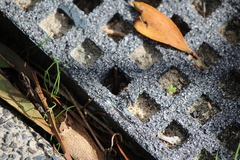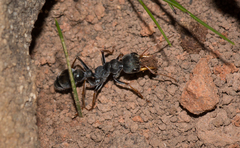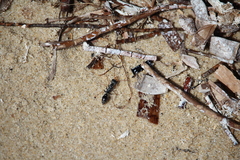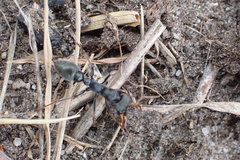The ant has black body with yellow jaws and yellow tips of legs and can move in a series of rapid jumps. Their nest in the ground usually has a mound of soil around the entrance. They feed on sweet secretions from plants and sap-sucking insects
They do not bite, but rather grasp the victim in their jaws, then bend around and sting them (their sting is in the tail)
Allergic reactions may occur to stings
The stings, like those of bees and wasps, are very painful. Local swelling is very common. Large local swellings can also occur, lasting a few days at a time. The most serious reactions are known as generalised allergic reactions, of which the most severe is anaphylaxis.
You can help suppport me bringing this information to you via my Paypal
What habitats does Myrmecia pilosula live in?
Open habitats, nesting in bushland, woodlands, and dry open forests, surrounded by gravel and sandy soil.
Locally a very common ant species
What is the distribution of Myrmecia pilosula?
South-eastern and south-western mainland Australia and Tasmania
How big does Myrmecia pilosula grow?
Worker body up to 1 cm long
You can support me by dropping some funds into my Paypal account
Disclaimer: A lot of work goes into trying to identify and ensure accurate identifications are made and that the listed Descriptions, Sizes, Habitats and Distribution information is as accurate and valid as possible. Unfortunately, information in this arena is ever changing and as such no guarantee can be offered that it is correct or currently valid as a result the information is provided as a guide, and it is always suggested that you do a little research to ensure you have the latest and most accurate information. View the reference's or bibliography I welcome any feedback and comments on the information provided.



